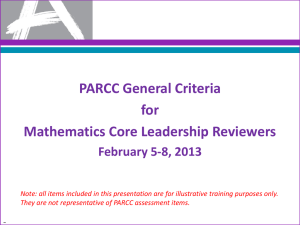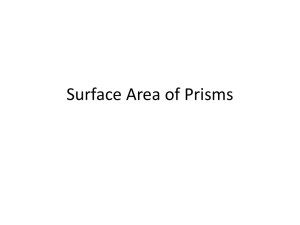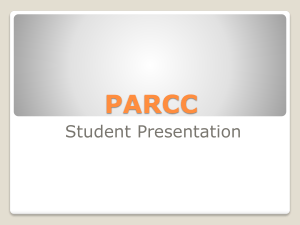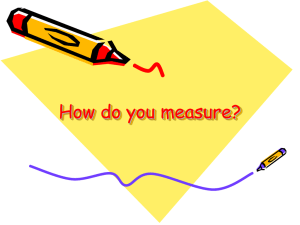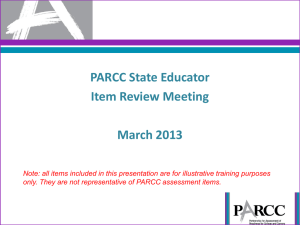Each task should
advertisement
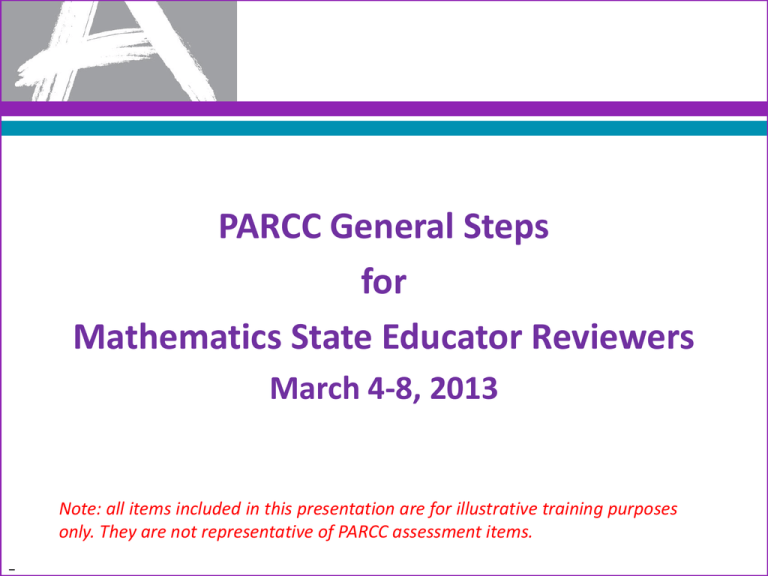
PARCC General Steps for Mathematics State Educator Reviewers March 4-8, 2013 Note: all items included in this presentation are for illustrative training purposes only. They are not representative of PARCC assessment items. 1 Step 1 2 Read and work each task independently. Review Tasks Independently Before Discussing Them as a Group Reviewers should: • review each task independently • record your comments in the comments section • preliminary decision on how to proceed with the task (accept, accept with edits, reject) – A task should be edited if it has a flaw that can be fixed or needs clarification. A task should only be rejected if it has a flaw that can not be addressed. – Each task will be discussed as a group after individual reviews. Preliminary decisions may be changed at that time. 3 Step 2 4 Verify that the task aligns to the intended evidence statement. Alignment to Evidence Statements and the CCSS Each task should: • assess the designated evidence statement • conform to the content clarifications, limits, and emphasis associated with the evidence statement 5 Alignment to Evidence Statements and the CCSS Reviewers should: • note alignment issues in the comments section • accept the task with edits if the task can easily be edited to make the task align to the evidence statement • reject the task if the task can not easily be edited to make the task fit the evidence statement 6 Sample: Step 2a Task Type: I Points: 1 Evidence Statement: 3.OA.4 Johnny has 8 crayons. He wants to give an equal number of crayons to each of his 4 friends. He wrote the equation 4 ? 8 to find the number of crayons he should give to each friend. How many crayons should Johnny give to each friend? Type your answer in the box. ? 7 Note: all items included in this presentation are for illustrative training purposes only. They are not representative of PARCC assessment items. Evidence Statement Text, Clarifications, Limits, Emphases and Other Information for 3.OA.4 Point Values Each task must be worth 1 point. Evidence Statement Text Determine the unknown whole number in a multiplication or division equation relating three whole numbers. For example, determine the unknown number that makes the equation true in each of the equations 8 ? 48, 5 Clarifications, Limits, Emphases, and Other Information 8 3, 6 6 ?. i) Tasks do not have a context. ii) Only the answer is required (methods, representations, etc. are not assessed here). iii) All products and related quotients are from the harder three quadrants of the times table (a × b where a > 5 and/or b > 5). Note: all items included in this presentation are for illustrative training purposes only. They are not representative of PARCC assessment items. Sample: Step 2b Task Type: I Points: 1 Evidence Statement: 8.G.7-1 A right rectangular prism is 16 inches wide, 12 inches long, and 12 inches tall. d 16 inches 12 inches 12 inches To the nearest inch, what is the length of the diagonal, d, of the rectangular prism? Type you answer in the box. d 9 Note: all items included in this presentation are for illustrative training purposes only. They are not representative of PARCC assessment items. Evidence Statement Text, Clarifications, Limits, Emphases and Other Information for 8.G.7-1 Point Values Each task must be worth 1 point. Evidence Statement Text Apply the Pythagorean Theorem in a simple planar case. Clarifications, Limits, Emphases, and Other Information 10 i) Tasks have “thin context” or no context. ii) Tasks require students to find one side of a right triangle in the plane, given the other two sides. iii) In 50% of tasks, the answer is a whole number and is to be given as a whole number. iv) In 50% of tasks, the answer is irrational and is to be given approximately to three decimal places. v) The testing interface can provide students with a calculation aid of the specified kind for these tasks. Evidence Statement Text, Clarifications, Limits, Emphases and Other Information for 8.G.7-2 Point Values Each task must be worth 1 point. Evidence Statement Text Apply the Pythagorean Theorem in a simple threedimensional case. Clarifications, Limits, Emphases, and Other Information 11 i) Tasks have “thin context” or no context. ii) Tasks require students to find one side of a right triangle in three dimensions, given information on a diagram that straightforwardly determines the other two sides. iii) In 50% of tasks, the answer is a whole number and is to be given as a whole number. iv) In 50% of tasks, the answer is irrational and is to be given approximately to three decimal places. v) The testing interface can provide students with a calculation aid of the specified kind for these tasks. Step 3 12 Determine if there are any mathematical flaws in the task (i.e. anything that makes the task unusable as written). Flaws Each task should: • contain content (text, stimuli, terminology, notation, art, etc.) that is mathematically correct, precise, and generally accepted by math educators • be free from flaws • not contain unintended mathematical errors, misconceptions, contradictions, or ambiguities 13 Sample: Step 3 Task Type: I Points: 1 Evidence Statement: 6.G.1 10 in. 5 in. 4 in. 14 in. What is the area of the isosceles trapezoid? square inches 14 Note: all items included in this presentation are for illustrative training purposes only. They are not representative of PARCC assessment items. Evidence Statement Text, Clarifications, Limits, Emphases and Other Information for 6.G.1 Point Values Each task must be worth 2 points. Evidence Statement Text Find the area of right triangles, other triangles, special quadrilaterals, and polygons by composing into rectangles or decomposing into triangles and other shapes; apply these techniques in the context of solving real-world and mathematical problems. Clarifications, Limits, Emphases, and Other Information i) 15 The testing interface can provide students with a calculation aid of the specified kind for these tasks Step 4 16 Review answer keys and rubrics for accuracy. Answer Keys and Scoring Rubrics Type I one-point tasks should: • have the correct key Scoring Rubrics should: • be clear enough so that the person scoring the response will know how to assign points based on different parts of the response • assign at least 50% of the total points to the reasoning/modeling provided in the response and less than 50% of the points to a computations provided in the response for Type II and Type III tasks 17 Sample: Step 4 Task Type: II Points: 4 Evidence Statement: 5.C.6/5.MD.5c Rosa needs to calculate the volume of a right prism. This diagram shows the dimensions of the prism. All angles in the base of the prism are right angles. 5 in. 4 in. 7 in. 7 in. 6 in. 12 in. 11 in. Show how Rosa can calculate the volume of the right prism. Be sure to explain why you chose the operations you use in your calculation, and include the volume of the prism. 18 Note: all items included in this presentation are for illustrative training purposes only. They are not representative of PARCC assessment items. Evidence Statement Text, Clarifications, Limits, Emphases and Other Information for 5.C.6 and 5.MD.5c Point Values Each task must be worth 3 or 4 points. Evidence Statement Text Base explanations/reasoning on concrete referents such as diagrams (whether provided in the prompt or constructed by the student in her response). Content Scope: Knowledge and skills articulated in 5.MD.C 5.C.6 Clarifications, Limits, Emphases, and Other Information Evidence Statement Text Relate the operations of multiplication and addition and solve real world and mathematical problems involving volume. c. Recognize volume as additive. Find volumes of solid figures composed of two non-overlapping right rectangular prisms by adding the volumes of the non-overlapping parts, applying this technique to solve real world problems. 5.MD.5c Clarifications, Limits, Emphases, and Other Information 19 – i) Tasks require students to solve a contextual problem by applying the indicated concepts and skills. Scoring Rubric for Sample Step 4 Scoring Rubric The task is worth 4 points; 1 point for computation and 3 points for reasoning. Computation component: 582 cubic inches Reasoning component: 1 point is awarded for a correct process in which the student shows or explains how to divide the prism into two (or more) right rectangular prisms 1 point is awarded for showing or explaining the correct calculations for determining the volume of each rectangular prism 1 point is awarded for showing or explaining that the volumes need to be added together to determine the volume of the entire prism. 20 Step 5 21 Advise to accept or reject the task. Advise to Accept or Reject Reviewers as a group • discuss any major comments • determine how to proceed with the task (accept, accept with edits, reject) – A task should be edited if it has a flaw that can be fixed or needs clarification. A task should only be rejected if it has a flaw that can not be addressed. 22 Questions?
